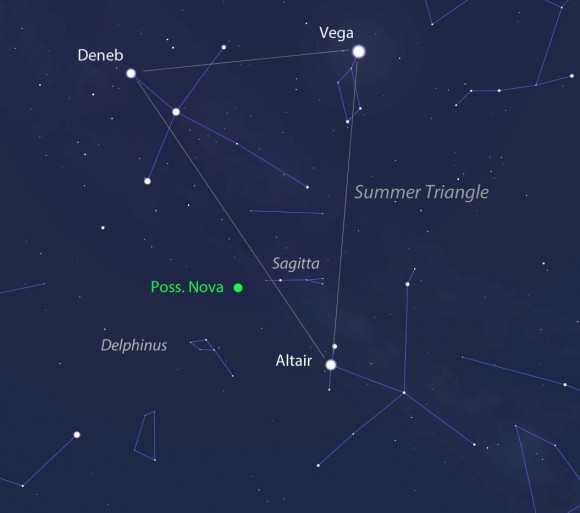
© StellariumThe possible new nova is located in Delphinus alongside the familiar Summer Triangle outlined by Deneb, Vega and Altair. This may shows the sky looking high in the south for mid-northern latitudes around 10 p.m. local time in mid-August. The new object is ideally placed for viewing.
Looking around for something new to see in your binoculars or telescope tonight? How about an object whose name literally means "new". Japanese amateur astronomer Koichi Itagaki of Yamagata discovered an apparent
nova or "new star" in the constellation Delphinus the Dolphin just today, August 14.
He used a small 7-inch (.18-m) reflecting telescope and CCD camera to nab it. Let's hope its mouthful of a temporary designation, PNVJ20233073+2046041, is soon changed to Nova Delphini 2013!
Several hours later it was confirmed as a new object shining at magnitude 6.8 just under the naked eye limit. This is bright especially considering that nothing was visible at the location down to a dim 13th magnitude only a day before discovery.
How bright it will get is hard to know yet, but variable star observer Patrick Schmeer of Germany got his eyes on it this evening and estimated the new object at
magnitude 6.0. That not only puts it within easy reach of all binoculars but right at the naked eye limit for observers under dark skies. Wow! Since it appears to have been discovered on day one of the outburst, my hunch is that it will brighten even further.
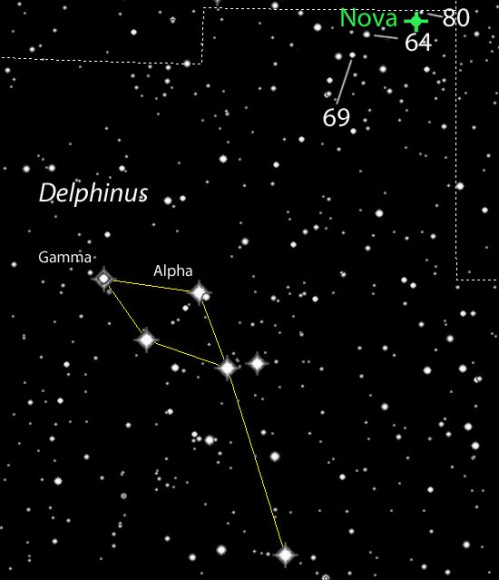
© Created with Chris Marriott’s SkyMapThis more detailed chart will help you find the new star in binoculars and small telescopes. The field containing the possible nova is about three fingers held at arm’s length above the top of the dolphin-shaped constellation Delphinus. Numbers are Tycho visual magnitudes for three stars near the nova.
The only way to know is to go out for a look. I've prepared a couple charts you can use to help you find and follow our new guest. The charts show stars down to about 9th magnitude, the limit for 50mm binoculars under dark skies. The numbers on the chart are magnitudes (with decimals omitted, thus 80 = 8.0 magnitude) so you can approximate its brightness and follow the ups and downs of the star's behavior in the coming nights.
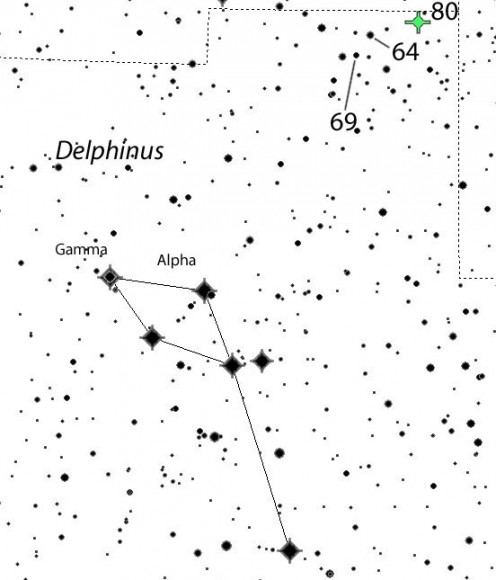
© Created with Chris Marriott’s SkyMapSome find reverse or “black stars on white” maps handier to use because they’re less cluttered. Stars are shown to 9th magnitude. The nova’s precise position is RA 20 h 23′ 31″, Dec. +20 deg. 46′.
Despite the name, a nova is not truly new but an explosion on a star otherwise too faint for anyone to have noticed. A nova occurs in a close binary star system, where a small but extremely dense and massive (for its size)
white dwarf grabs hydrogen gas from its closely orbiting companion. After swirling about in a disk around the dwarf, it's funneled down to the star's 150,000 degree F surface where gravity compacts and heats the gas until it until detonates like a bazillion thermonuclear bombs. Suddenly, a faint star that wasn't on anyone's radar vaults a dozen magnitudes to become a standout "new star".
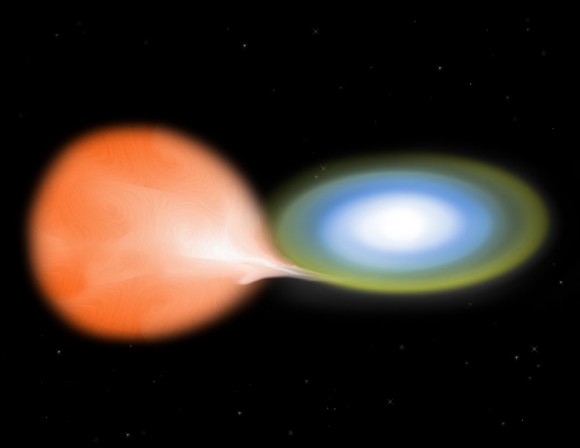
© NASA/CXC/M. WeissModel of a nova in the making. A white dwarf star pulls matter from its bloated red giant companion into a whirling disk. Material funnels to the surface where it later explodes.
Novae can rise in brightness from 7 to 16 magnitudes, the equivalent of 50,000 to 100,000 times brighter than the sun, in just a few days. Meanwhile the gas they expel in the blast travels away from the binary at up to 2,000 miles per second. This one big boom! Unlike a supernova explosion, the star survives, perhaps to "go nova" again someday.
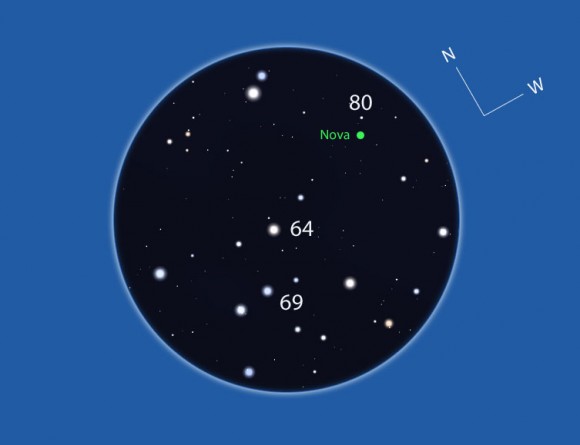
© StellariumCloser view yet of the apparent nova showing a circle with a field of view of about 2 degrees.
I'll update with links to other charts in the coming day or two, so check back.
See info on the Remanzacco Observatory website about their followup images of the nova.








It’s said that the Model seen in this article .. is of a nova star in the making, as a white dwarf star is seen pilling matter from its bloated red giant companion into a whirling disk, as cosmic material is funneled to the surface which later explodes .. Yet in celestial knowing I consider this event to be the inhaling process of a giant white-light lunar sphere’s fueling itself, for the process of quantum leap jump .. when after a specific acceleration mark is reached, quantum leap of the Giant White Lunar Sphere is accomplished … and in doing so, a very Bright White Light is produced which have been called and explosion, yet scripture refers to it as the Glory mark of God .. I consider this event to be a successful quantum leap jump in the establishment of an enclosed vast bubble of open atmosphere AKA Heaven AKA New Inner Dimensional World held in a state of hyperspace .. Yet scripture also says …“And no marvel; for Satan himself is transformed into an angel of light” … and just as all that glitter isn’t gold … all that glows isn’t of the Positive Light, yet there are those that are …